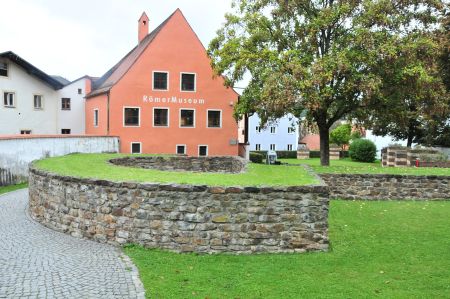Passau - The Museum Roman Boiotro Castle
- Written by Portal Editor
Within our stay at Passau, we wanted to spend some of our limited time exploring Roman trails in Passau, especially since we had heard a lot about Passau's Roman past during our last stay in Regensburg.
And even if there are only few visible traces in the inner city, the Roman Museum Boiotro in the centre of Passau is worth a visit. As it was quite cool this autumn day already, the museum also offered the charm of not being in the rain.
Boiotro Castle - inside there are various remains from Roman times
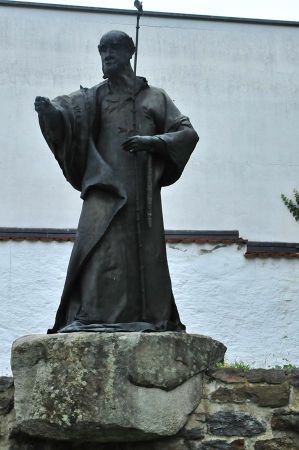 The Boiotro Museum was built on the foundations of the late Roman fort Boiotro, so the rest of the military fortifications can be seen in the open air part of the museum.
The Boiotro Museum was built on the foundations of the late Roman fort Boiotro, so the rest of the military fortifications can be seen in the open air part of the museum.
As well as some of the remains of the original foundations are inside the museum.
The remains of the castle were released after sporadic earlier excavations, mainly in the 1970th.
The spatial connection between the site and the museum gives the visitor an insight view into the early history of Passau and its surroundings as well as into archaeological practice, as the museum is housed in a modernized late-medieval building.
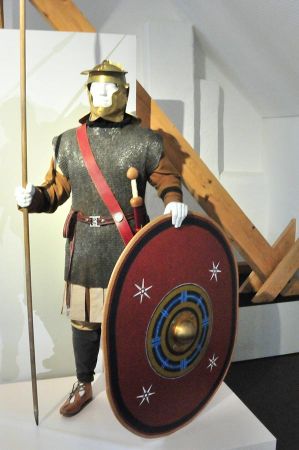 A first Celtic settlement goes back to the La Tène period, when a village settlement with a Danube port at the height of today's old town hall was being built.
A first Celtic settlement goes back to the La Tène period, when a village settlement with a Danube port at the height of today's old town hall was being built.
The Roman fort Batavis (Castra Batava) was built on the site of the present cathedral as part of the Limes fortification along the Danube.
The name "Batavis" derives from the Germanic mercenaries stationed there, a Bataver tribe.
Batavis also developed the current name "Passau".
Between 476 and 490 the Roman troops left the region
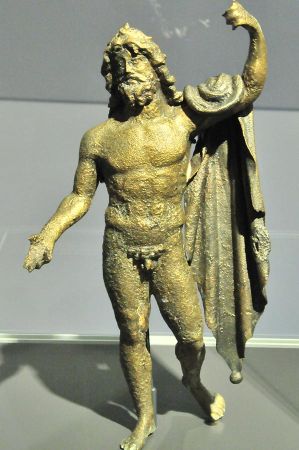 In the first century AD, as a part of the Roman province of Raetia, on the right bank of the river, the Boiodurum Castle was being built, which lasted until a German invasion in the second half of the 3rd century.
In the first century AD, as a part of the Roman province of Raetia, on the right bank of the river, the Boiodurum Castle was being built, which lasted until a German invasion in the second half of the 3rd century.
Its tasks were taken over by the Boiotro fortress, erected in the Late Roman Empire, in the Roman province of Noricum, which continued until the retreat of the novel Vita Severini where it is described that the garrison there lasted longer than elsewhere, when in the second half of the fifth century the legions were not paid anymore.
Probably between 476 and 490 the Roman troops left the region.
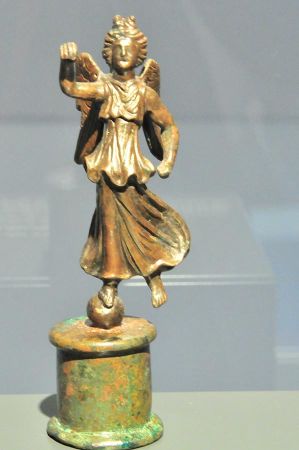 Saint Severin, the missionary of the Noricum, probably built a monastery in the ruins of the Roman colony at the end of the fifth century.
Saint Severin, the missionary of the Noricum, probably built a monastery in the ruins of the Roman colony at the end of the fifth century.
The name Boiotro (late Latin for the name of the predecessor fortune Boiodurum) was preserved to the present.
The baju goods, which took possession of the area in the 6th century, erected a Duke's castle on the peninsula.
Already in 739 Passau was seat of a bishop, at that time the monastery of Niedernburg was founded, which owned large lands in the area along the Ilz river.
Museum focus is on digging results of the Roman period
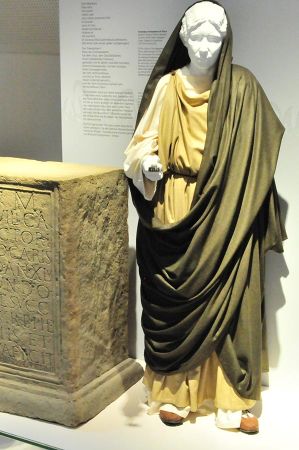 The museum's exhibition, opened in 1982, is limited to findings from the East Bavarian region and Passau itself. The collection's time horizon ranges from the Stone Age to the Modern Age.
The museum's exhibition, opened in 1982, is limited to findings from the East Bavarian region and Passau itself. The collection's time horizon ranges from the Stone Age to the Modern Age.
A clear focus, however, is being put on the history of the Passau settlement as well as on the findings and excavation results of the Roman era together with the model reconstruction of the Roman settlement.
Please read as well:
Regensburg Festival of German-Turkish Literature
Journey of Intimicy and Culture along the Roman Roads
-
 Passau - Roman Museum Kastell Boiotro
Passau - Roman Museum Kastell Boiotro
Passau - Roman Museum Kastell Boiotro
Passau - Roman Museum Kastell Boiotro
-
 Passau - Roman Museum Kastell Boiotro
Passau - Roman Museum Kastell Boiotro
Passau - Roman Museum Kastell Boiotro
Passau - Roman Museum Kastell Boiotro
-
 Passau - Roman Museum Kastell Boiotro
Passau - Roman Museum Kastell Boiotro
Passau - Roman Museum Kastell Boiotro
Passau - Roman Museum Kastell Boiotro
-
 Passau - Roman Museum Kastell Boiotro
Passau - Roman Museum Kastell Boiotro
Passau - Roman Museum Kastell Boiotro
Passau - Roman Museum Kastell Boiotro
-
 Passau - Roman Museum Kastell Boiotro
Passau - Roman Museum Kastell Boiotro
Passau - Roman Museum Kastell Boiotro
Passau - Roman Museum Kastell Boiotro
-
 Passau - Roman Museum Kastell Boiotro
Passau - Roman Museum Kastell Boiotro
Passau - Roman Museum Kastell Boiotro
Passau - Roman Museum Kastell Boiotro
-
 Passau - Roman Museum Kastell Boiotro
Passau - Roman Museum Kastell Boiotro
Passau - Roman Museum Kastell Boiotro
Passau - Roman Museum Kastell Boiotro
-
 Passau - Roman Museum Kastell Boiotro
Passau - Roman Museum Kastell Boiotro
Passau - Roman Museum Kastell Boiotro
Passau - Roman Museum Kastell Boiotro
-
 Passau - Roman Museum Kastell Boiotro
Passau - Roman Museum Kastell Boiotro
Passau - Roman Museum Kastell Boiotro
Passau - Roman Museum Kastell Boiotro
-
 Passau - Roman Museum Kastell Boiotro
Passau - Roman Museum Kastell Boiotro
Passau - Roman Museum Kastell Boiotro
Passau - Roman Museum Kastell Boiotro
-
 Passau - Roman Museum Kastell Boiotro
Passau - Roman Museum Kastell Boiotro
Passau - Roman Museum Kastell Boiotro
Passau - Roman Museum Kastell Boiotro
-
 Passau - Roman Museum Kastell Boiotro
Passau - Roman Museum Kastell Boiotro
Passau - Roman Museum Kastell Boiotro
Passau - Roman Museum Kastell Boiotro
-
 Passau - Roman Museum Kastell Boiotro
Passau - Roman Museum Kastell Boiotro
Passau - Roman Museum Kastell Boiotro
Passau - Roman Museum Kastell Boiotro
-
 Passau - Roman Museum Kastell Boiotro
Passau - Roman Museum Kastell Boiotro
Passau - Roman Museum Kastell Boiotro
Passau - Roman Museum Kastell Boiotro
-
 Passau - Roman Museum Kastell Boiotro
Passau - Roman Museum Kastell Boiotro
Passau - Roman Museum Kastell Boiotro
Passau - Roman Museum Kastell Boiotro
-
 Passau - Roman Museum Kastell Boiotro
Passau - Roman Museum Kastell Boiotro
Passau - Roman Museum Kastell Boiotro
Passau - Roman Museum Kastell Boiotro
-
 Passau - Roman Museum Kastell Boiotro
Passau - Roman Museum Kastell Boiotro
Passau - Roman Museum Kastell Boiotro
Passau - Roman Museum Kastell Boiotro
-
 Passau - Roman Museum Kastell Boiotro
Passau - Roman Museum Kastell Boiotro
Passau - Roman Museum Kastell Boiotro
Passau - Roman Museum Kastell Boiotro
-
 Passau - Roman Museum Kastell Boiotro
Passau - Roman Museum Kastell Boiotro
Passau - Roman Museum Kastell Boiotro
Passau - Roman Museum Kastell Boiotro
-
 Passau - Roman Museum Kastell Boiotro
Passau - Roman Museum Kastell Boiotro
Passau - Roman Museum Kastell Boiotro
Passau - Roman Museum Kastell Boiotro
-
 Passau - Roman Museum Kastell Boiotro
Passau - Roman Museum Kastell Boiotro
Passau - Roman Museum Kastell Boiotro
Passau - Roman Museum Kastell Boiotro
-
 Passau - Roman Museum Kastell Boiotro
Passau - Roman Museum Kastell Boiotro
Passau - Roman Museum Kastell Boiotro
Passau - Roman Museum Kastell Boiotro
-
 Passau - Roman Museum Kastell Boiotro
Passau - Roman Museum Kastell Boiotro
Passau - Roman Museum Kastell Boiotro
Passau - Roman Museum Kastell Boiotro
-
 Passau - Roman Museum Kastell Boiotro
Passau - Roman Museum Kastell Boiotro
Passau - Roman Museum Kastell Boiotro
Passau - Roman Museum Kastell Boiotro
-
 Passau - Roman Museum Kastell Boiotro
Passau - Roman Museum Kastell Boiotro
Passau - Roman Museum Kastell Boiotro
Passau - Roman Museum Kastell Boiotro
-
 Passau - Roman Museum Kastell Boiotro
Passau - Roman Museum Kastell Boiotro
Passau - Roman Museum Kastell Boiotro
Passau - Roman Museum Kastell Boiotro
-
 Passau - Roman Museum Kastell Boiotro
Passau - Roman Museum Kastell Boiotro
Passau - Roman Museum Kastell Boiotro
Passau - Roman Museum Kastell Boiotro
-
 Passau - Roman Museum Kastell Boiotro
Passau - Roman Museum Kastell Boiotro
Passau - Roman Museum Kastell Boiotro
Passau - Roman Museum Kastell Boiotro
-
 Passau - Roman Museum Kastell Boiotro
Passau - Roman Museum Kastell Boiotro
Passau - Roman Museum Kastell Boiotro
Passau - Roman Museum Kastell Boiotro
-
 Passau - Roman Museum Kastell Boiotro
Passau - Roman Museum Kastell Boiotro
Passau - Roman Museum Kastell Boiotro
Passau - Roman Museum Kastell Boiotro
https://www.alaturka.info/en/germany/bavaria/3500-passau-the-museum-roman-boiotro-castle#sigProId111993ef47
